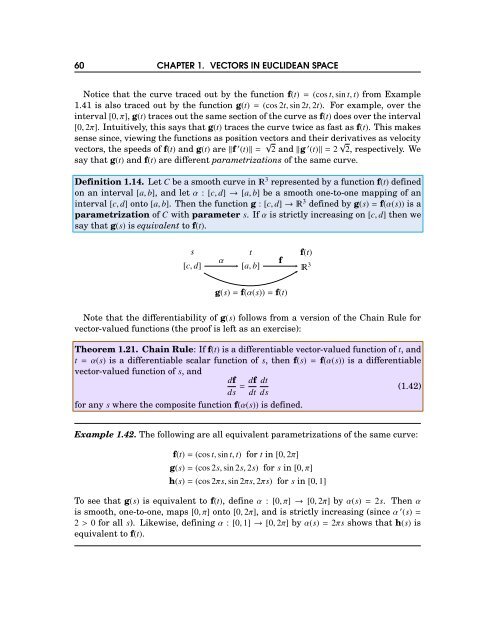Michael Corral: Vector Calculus
Michael Corral: Vector Calculus
Michael Corral: Vector Calculus
You also want an ePaper? Increase the reach of your titles
YUMPU automatically turns print PDFs into web optimized ePapers that Google loves.
60 CHAPTER 1. VECTORS IN EUCLIDEAN SPACE<br />
Notice that the curve traced out by the function f(t)=(cost,sint,t) from Example<br />
1.41 is also traced out by the function g(t)=(cos2t,sin2t,2t). For example, over the<br />
interval[0,π],g(t)tracesoutthesamesectionofthecurveasf(t)doesovertheinterval<br />
[0,2π]. Intuitively, this says that g(t) traces the curve twice as fast as f(t). This makes<br />
sense since, viewing the functions as position vectors and their derivatives as velocity<br />
vectors, the speeds of f(t) and g(t) are‖f ′ (t)‖= √ 2 and‖g ′ (t)‖=2 √ 2, respectively. We<br />
say that g(t) and f(t) are different parametrizations of the same curve.<br />
Definition 1.14. LetC be a smooth curve in 3 represented by a function f(t) defined<br />
on an interval [a,b], and letα : [c,d]→[a,b] be a smooth one-to-one mapping of an<br />
interval [c,d] onto [a,b]. Then the function g : [c,d]→ 3 defined by g(s)=f(α(s)) is a<br />
parametrization of C with parameter s. Ifαis strictly increasing on [c,d] then we<br />
say that g(s) is equivalent to f(t).<br />
s t f(t)<br />
α f<br />
[c,d] [a,b] 3<br />
g(s)=f(α(s))=f(t)<br />
Note that the differentiability of g(s) follows from a version of the Chain Rule for<br />
vector-valued functions (the proof is left as an exercise):<br />
Theorem 1.21. Chain Rule: If f(t) is a differentiable vector-valued function of t, and<br />
t=α(s) is a differentiable scalar function of s, then f(s)=f(α(s)) is a differentiable<br />
vector-valued function of s, and<br />
df<br />
ds = df<br />
dt<br />
dt<br />
ds<br />
for any s where the composite function f(α(s)) is defined.<br />
(1.42)<br />
Example 1.42. The following are all equivalent parametrizations of the same curve:<br />
f(t)=(cost,sint,t) for t in [0,2π]<br />
g(s)=(cos2s,sin2s,2s) for s in [0,π]<br />
h(s)=(cos2πs,sin2πs,2πs) for s in [0,1]<br />
To see that g(s) is equivalent to f(t), defineα : [0,π]→[0,2π] byα(s)=2s. Thenα<br />
is smooth, one-to-one, maps [0,π] onto [0,2π], and is strictly increasing (sinceα ′ (s)=<br />
2>0 for all s). Likewise, definingα : [0,1]→[0,2π] byα(s)=2πs shows that h(s) is<br />
equivalent to f(t).








